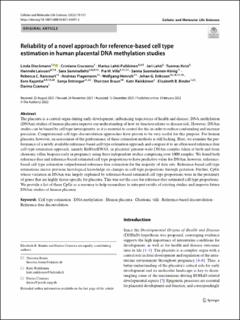| dc.contributor.author | Dieckmann, Linda | |
| dc.contributor.author | Cruceanu, Cristiana | |
| dc.contributor.author | Lahti-Pulkkinen, Marius | |
| dc.contributor.author | Lahti, Jari | |
| dc.contributor.author | Kvist, Tuomas | |
| dc.contributor.author | Laivuori, Hannele | |
| dc.contributor.author | Sammallahti, Sara | |
| dc.contributor.author | Villa, Pia M. | |
| dc.contributor.author | Suomalainen-König, Sanna | |
| dc.contributor.author | Rancourt, Rebecca C. | |
| dc.contributor.author | Plagemann, Andreas | |
| dc.contributor.author | Henrich, Wolfgang | |
| dc.contributor.author | Eriksson, Johan G. | |
| dc.contributor.author | Kajantie, Eero Olavi | |
| dc.contributor.author | Entringer, Sonja | |
| dc.contributor.author | Braun, Thorsten | |
| dc.contributor.author | Räikkönen, Katri | |
| dc.contributor.author | Binder, Elisabeth B. | |
| dc.contributor.author | Czamara, Darina | |
| dc.date.accessioned | 2023-05-09T14:49:52Z | |
| dc.date.available | 2023-05-09T14:49:52Z | |
| dc.date.created | 2022-04-27T13:13:38Z | |
| dc.date.issued | 2022 | |
| dc.identifier.citation | Cellular and Molecular Life Sciences (CMLS). 2022, 79 (2), . | en_US |
| dc.identifier.issn | 1420-682X | |
| dc.identifier.uri | https://hdl.handle.net/11250/3067363 | |
| dc.description.abstract | The placenta is a central organ during early development, influencing trajectories of health and disease. DNA methylation (DNAm) studies of human placenta improve our understanding of how its function relates to disease risk. However, DNAm studies can be biased by cell type heterogeneity, so it is essential to control for this in order to reduce confounding and increase precision. Computational cell type deconvolution approaches have proven to be very useful for this purpose. For human placenta, however, an assessment of the performance of these estimation methods is still lacking. Here, we examine the performance of a newly available reference-based cell type estimation approach and compare it to an often-used reference-free cell type estimation approach, namely RefFreeEWAS, in placental genome-wide DNAm samples taken at birth and from chorionic villus biopsies early in pregnancy using three independent studies comprising over 1000 samples. We found both reference-free and reference-based estimated cell type proportions to have predictive value for DNAm, however, reference-based cell type estimation outperformed reference-free estimation for the majority of data sets. Reference-based cell type estimations mirror previous histological knowledge on changes in cell type proportions through gestation. Further, CpGs whose variation in DNAm was largely explained by reference-based estimated cell type proportions were in the proximity of genes that are highly tissue-specific for placenta. This was not the case for reference-free estimated cell type proportions. We provide a list of these CpGs as a resource to help researchers to interpret results of existing studies and improve future DNAm studies of human placenta. | en_US |
| dc.language.iso | eng | en_US |
| dc.publisher | Springer | en_US |
| dc.rights | Navngivelse 4.0 Internasjonal | * |
| dc.rights.uri | http://creativecommons.org/licenses/by/4.0/deed.no | * |
| dc.title | Reliability of a novel approach for reference-based cell type estimation in human placental DNA methylation studies | en_US |
| dc.title.alternative | Reliability of a novel approach for reference-based cell type estimation in human placental DNA methylation studies | en_US |
| dc.type | Peer reviewed | en_US |
| dc.type | Journal article | en_US |
| dc.description.version | publishedVersion | en_US |
| dc.source.pagenumber | 0 | en_US |
| dc.source.volume | 79 | en_US |
| dc.source.journal | Cellular and Molecular Life Sciences (CMLS) | en_US |
| dc.source.issue | 2 | en_US |
| dc.identifier.doi | 10.1007/s00018-021-04091-3 | |
| dc.identifier.cristin | 2019522 | |
| cristin.ispublished | true | |
| cristin.fulltext | original | |
| cristin.qualitycode | 1 | |

